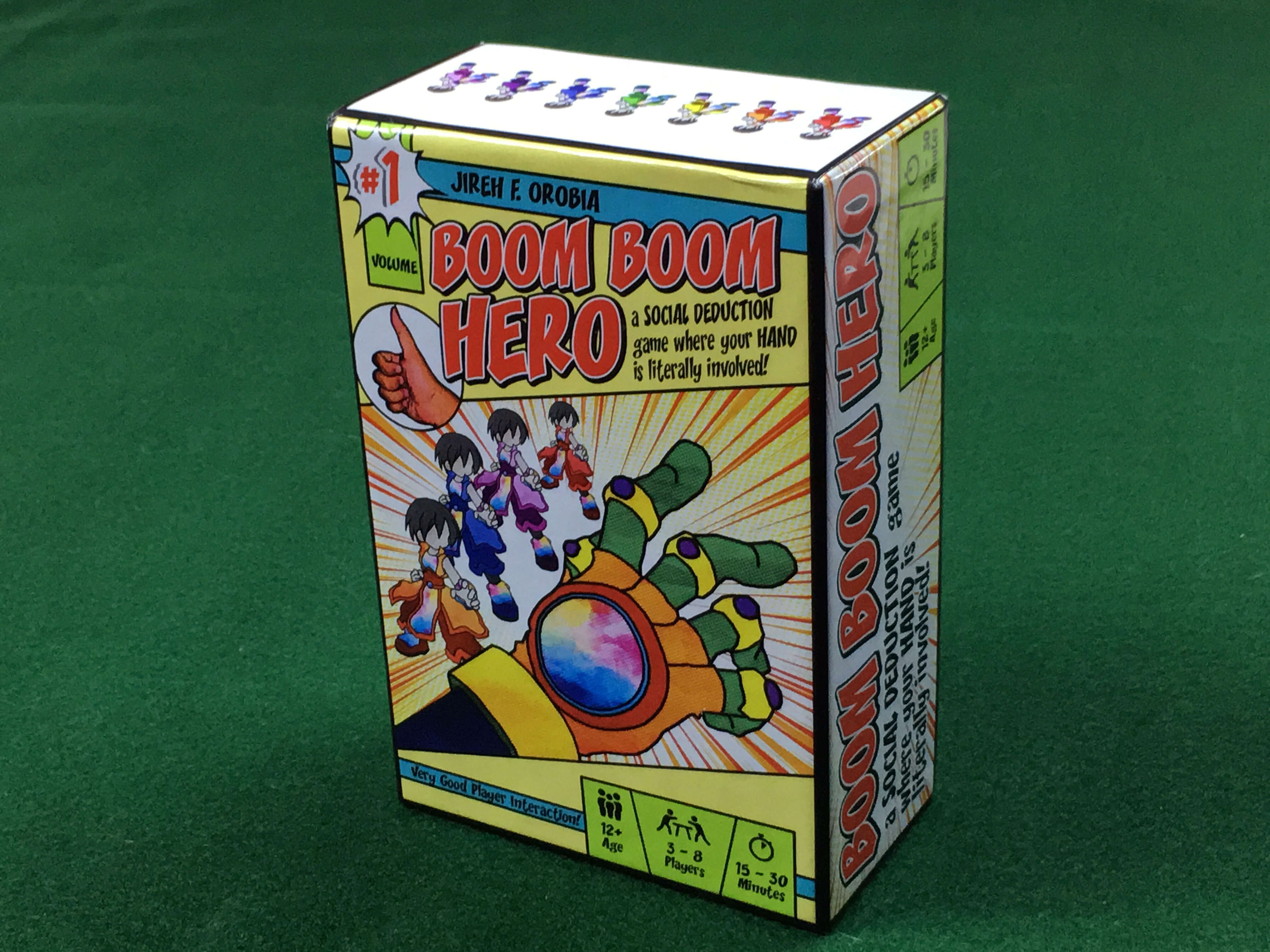
Boom Boom Hero is a game by Jireh F. Orobia that pits players against one one another in an imaginary battle arena fighting for the right to call themselves the next Boom Hero.
Each player receives a different hidden goal such as having the least damage or the most energy left at the end of the game. Each turn, players allocate the amount of energy they will spend towards an action from an open card market and simultaneously reveal their action using the matching hand gesture. Players also gain points for guessing all of the other players’ hidden objectives at the end of the game.
This is one in a series of seven articles outlining my judging decisions for the finalists in The Game Crafter‘s social deduction game design challenge. You can see the full article list here.
Visit Gamified Content’s YouTube channel to watch my review of Boom Boom Hero’s shop page from the semi-finalist judging round.
High-Level Review
The graphic design and presentation for this game was top-notch, and it was easy to gather a large group excited to give it a try. The simultaneous hand gestures and the group chant of “boom boom (action)!” each round were engaging and made for a great large group activity.
At the end of the game, several players said they felt the goals for their secret roles were impossible to achieve with the actions available to them during the game. More work on balancing the role requirements with the available actions could fix this issue.
Some of the guessing chips were misprinted, which created extra confusion for us during our guessing phase. Even if the chips hadn’t been misprinted, though, using the chips for guessing was the least enjoyable part of the game.
The end game scoring was not differentiated enough through correctly guessing others’ roles. Correct guesses would need to be worth more points for this aspect of the game to have an effect on who wins or loses.
Components
The game comes in a small stout box and has bright, compelling cover art with a fun comic book style.
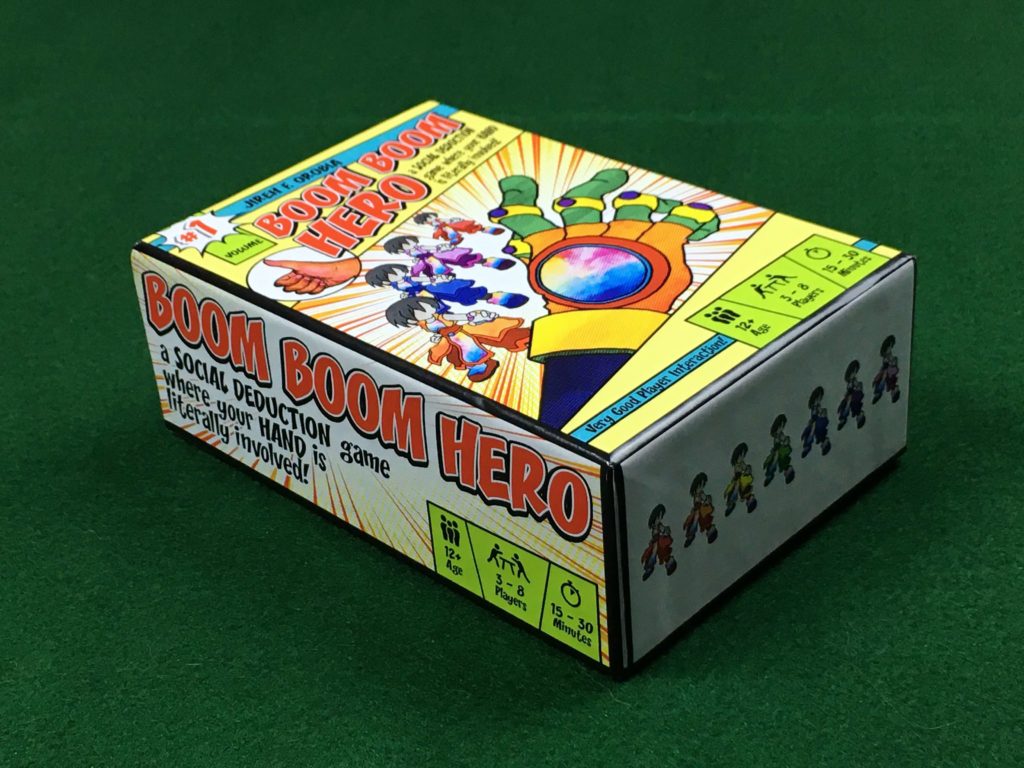
The back of the box has a clear description of what to expect from the game play as well as a nice picture of the components and game setup.
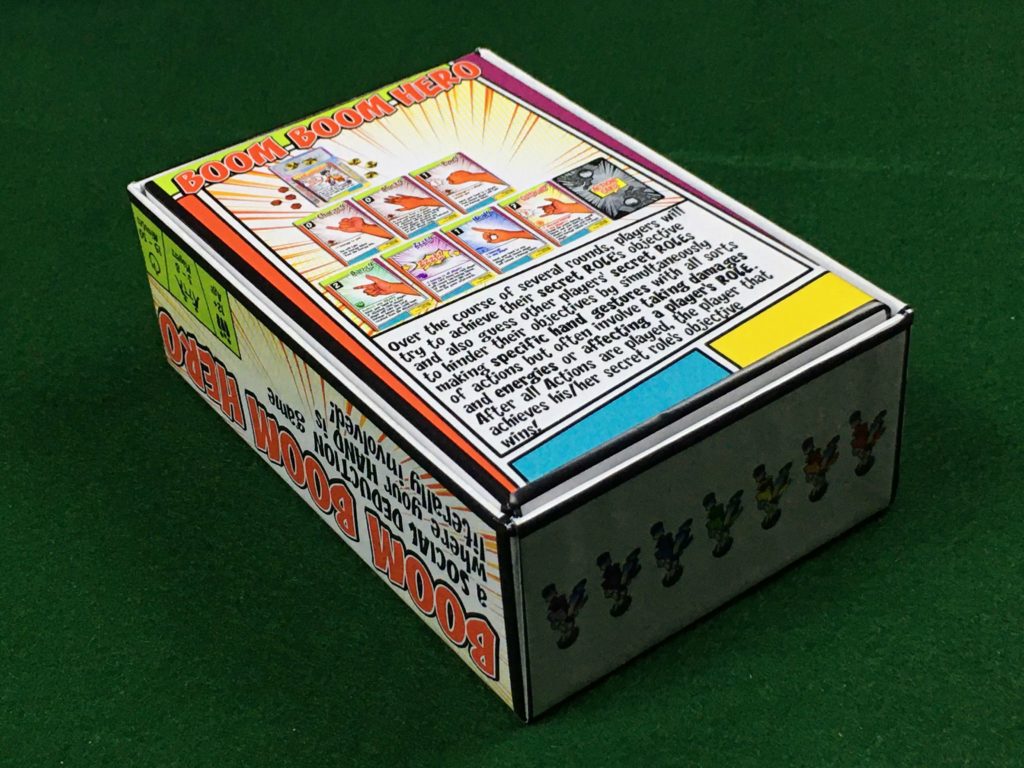
The game uses a mix of cards, laser cut chits, and plastic bits. The below picture shows the box contents after I punched out the chits and stored them in a plastic zip bag.
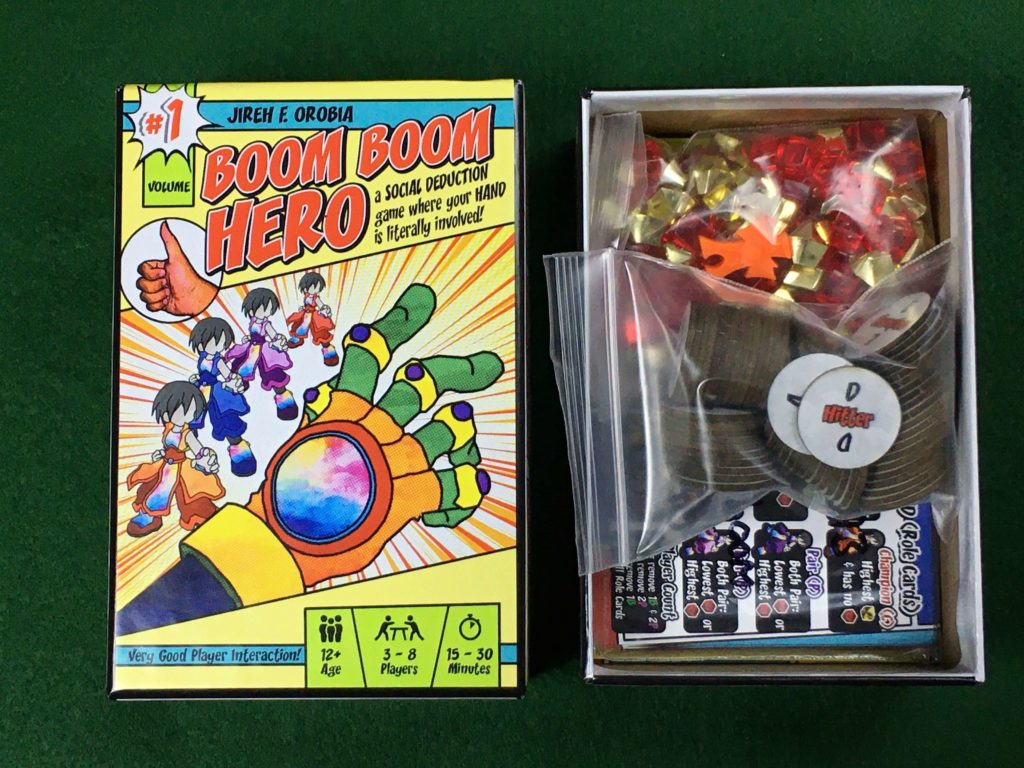
Charge!, Pow!, and Block! are the 3 main action cards. They stay available through the whole game. There are 19 additional action cards players shuffle and add to the action options 4 at a time.
Players use the chits at the end of the game for guessing others’ roles.
The gold crystals are the energy tokens, the red cubes are the damage tokens, and the little orange robot is the first player marker.
The last few cards are the player mats, player aids, and secret roles.
It also comes with a 16 page rule book with plenty of diagrams and fun comic art graphic design.
The illustration on all of the cards is well done and does a great job of incorporating a consistent comic book theme. The font choice fits perfectly, and the character illustrations, though only differentiated by clothing color, are cute and fun.
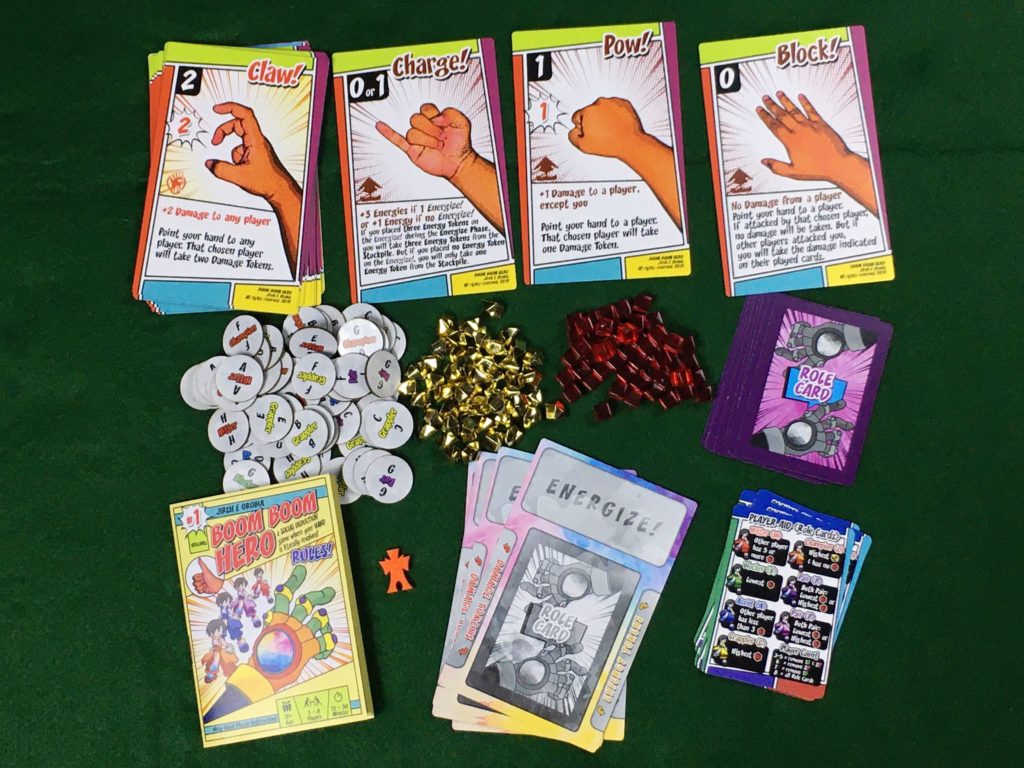
Each player has their own set of guessing chips labeled with a letter to create a set. The player mat has a spot for the player’s face-down role card, sides for damage and energy token reserves, and a spot for showing other players the amount of energy they will spend in a round before everyone simultaneously selects their actions. I found the layout of the player mat easy to use and understand.
The role side of the player aid looks great and is easy to quickly reference to see what goals other players might be working towards.
The opposite side of the player aid has an overview of round phases. I personally didn’t look at this side at all during the game. I felt the round sequence was simple and easy to remember. Reading through this reference after the fact, some of the wording is more confusing than the way things are explained in the rule book, so this text could use a bit of editing and clarification.
The placement of the Boom Gauntlet illustrations on the back of the role cards ended up making the cards look like cassette tapes. I don’t think of this game as 80s or 90s themed, so I doubt this was intentional. It didn’t have a negative impact on game play, but I did find it slightly distracting during setup.
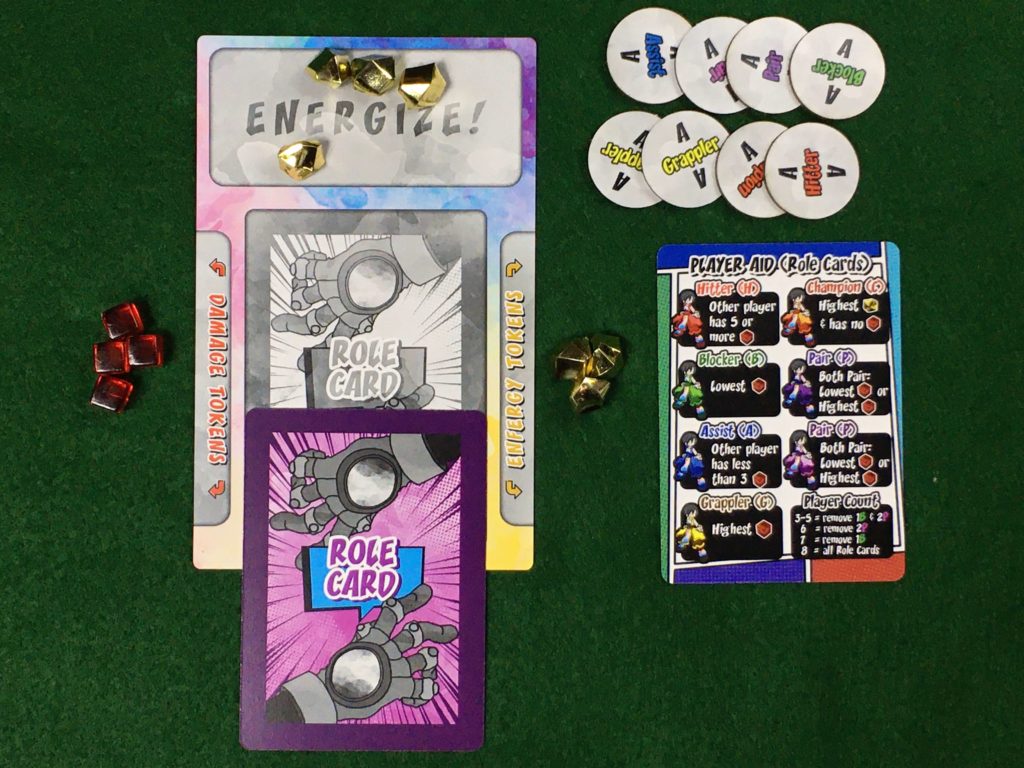
The action cards are jumbo sized, making them easy for everyone to see even when playing with a full group of 8 players. The wide variety of hand gestures on the action cards are fun and interesting. They leave me wondering if any of them were inspired by sign language.
The cards come in 4 categories which are labeled by the icons to the lower left of the hand gesture. I didn’t feel these symbols helped me identify the best action to use, so I can’t see a clear purpose for them. The main action cards’ symbol can serve to remind you that they are always available, but the rest of the symbols got more or less ignored. The main action cards also have a different back than the rest of the cards to help you identify them during setup, so the need for even the main action icon is debatable.
Several players said they felt there was too much text in the description of each of the action cards. Many times the black text was simply a more specific and wordy explanation of the colored heading text. I think it would make the cards feel less overwhelming if all of the black text from the cards were moved to a card reference at the back of the rule book.
I found it interesting that each individual card had a designer and artist credit in the lower right corner. While this is fairly uncommon, I thought it fit nicely into the comic book layout on these cards and was pretty easy to tune out once I realized it wasn’t important to mechanics.
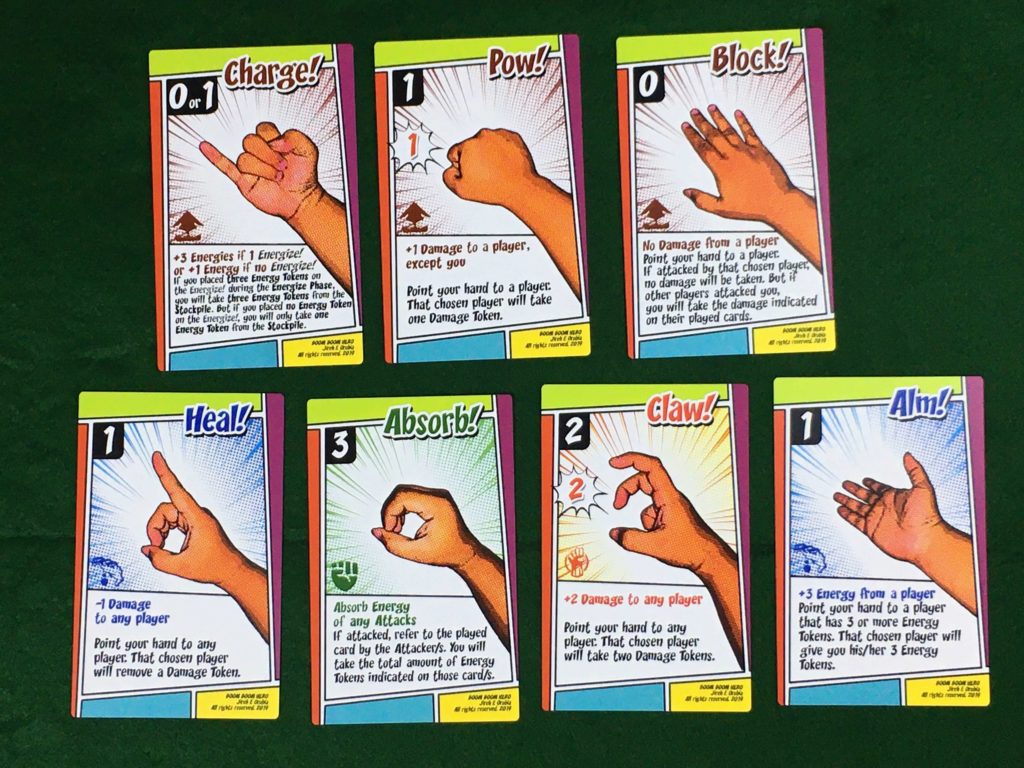
The role counts on the guessing chips were unfortunately mismatched to the role cards, player aids, and rule book in this printing with 2 Grapplers and 1 Blocker in each set of chips when the role cards and rule book/player aid role list represented 1 Grappler and 2 Blockers.
This caused our group some frustration during the guessing phase. By the end of the game, many of us forgot which roles the rules told us we were using during setup. We therefore trusted the role names on our chips and ended up with at least one guess that couldn’t possibly be correct.
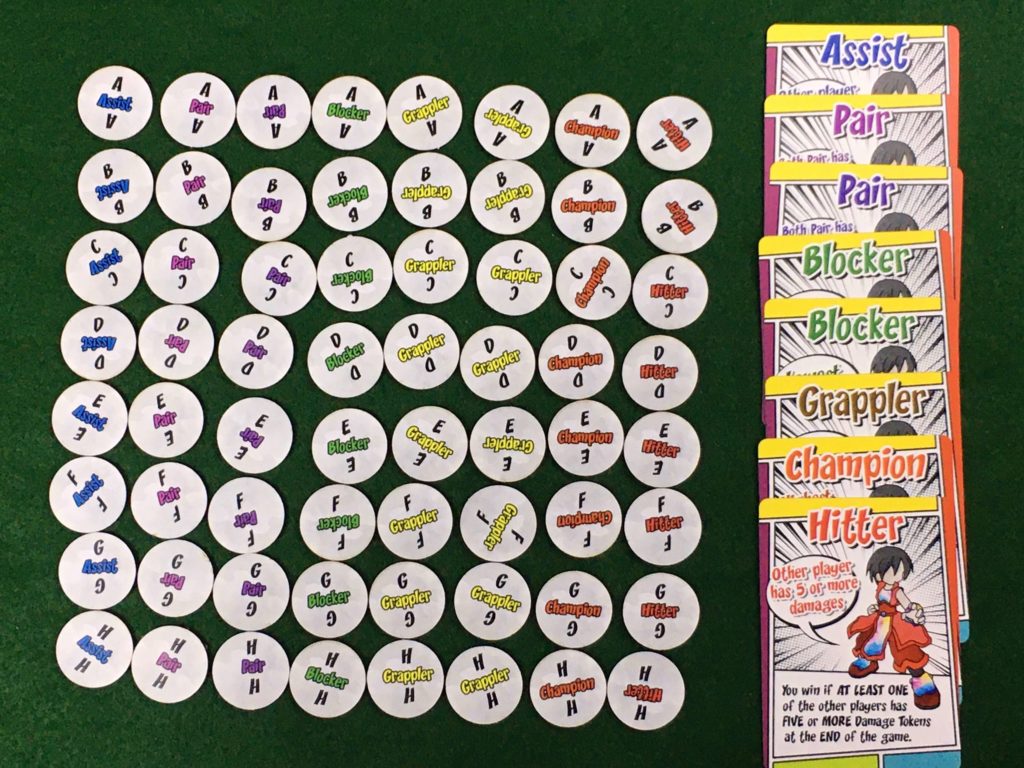
Misprinting issues aside, I don’t think the chips are the best type of component to use in the guessing phase. Sorting them during setup was work intensive, and passing them out at the end was unnecessarily time consuming.
Even worse, since the guessing chips were double-sided, we were all giving away our guesses to all the other players as we placed the chips according to turn order, which made guessing first a major disadvantage.
There was also nothing to designate which person was, for example, guesser A anywhere in that player’s area once they handed out all of their guessing chips — except maybe the chip that matched their own role, which would be a major tell if they didn’t hide it. And, honestly, even if they did hide it, other players could easily figure out what it must be, since the active roles are based on player count and open knowledge.
Assuming TGC is the printer, the following changes to the components could work better and reduce cost:
- Remove the chip board guessing tokens entirely.
- Add letters to the player mats so that each player has a designated letter separate from their role.
- Use UV coating on all cards.
- Add boxes on the player aid to write the number of each role active in this play as well as a box to write the letter of the player you think has that role.
- Include some dry erase markers players can pass around to mark off their guesses on their player aids.
If this was the setup, players could simultaneously reveal their guesses at the end of the game. This would take less time and remove the possibility of inadvertently revealing your own role during the guessing phase.
Game Play and Mechanics
The card market has 3 cheap actions that remain available throughout the game and 4 additional actions each round. Whenever at least one player uses one of the additional actions, they replace it with a new card. The game ends when these cards run out. Two of the additional actions have an immediate and automatic effect and cycle between rounds as soon as they appear.
A little less than half of the additional actions cost 4 or more energy, which takes 2 rounds to accumulate using the main Charge! action. For better or worse, this makes it likely that some, if not all, of the additional action cards will be stuck in the card market for several rounds. On one hand, this creates a race to use the cards. On the other hand, it can make the flow of additional action options feel jammed up and frustratingly inaccessible.
Since the average cost of the additional action cards is a little over 3 energy, setting up the players with only one energy token for their first round makes it likely everyone will chose a main action (with the Charge! action as the most likely choice among them). If the players could start with 4 energy tokens in their reserve (or maybe 3 tokens with the average cost of the special actions reduced to a little over 2), the game could get off to a more exciting start.
The simplest Heal! action to remove 1 damage from any player was not a main action, which meant it only showed up once per game. Considering that there are a couple of secret roles with goals centered around keeping someone’s damage very low, it felt to our group like Heal! should be one of the main actions.
In general, energy tokens felt too limited in our play through. Especially since over-allocating energy before revealing your action is a major way of bluffing in the game, it felt like all players should have had a larger supply of energy.
As mentioned above, the end-game guessing phase was clunky and gave an unfair advantage to people guessing later in turn order.
The other issue with the guessing phase was that the single point given for a correct guess was majorly outmatched by the 10 points players earned for meeting their secret goal. Even in an 8 player game, it would only be possible to get 7 points for correct guesses, which would not help you win if you weren’t able to reach your goal.
If all the goals were equally easy to achieve, it could make sense for guessing to only serve as the tie breaker among the people who met their goal, but, as the actions and role goals currently stand, the different goals are not equally easy to achieve.
Scoring
The following scoring breakdown is based on a rubric I released during the game design challenge on TGC’s contest page. All sections are worth a maximum of 1 point.
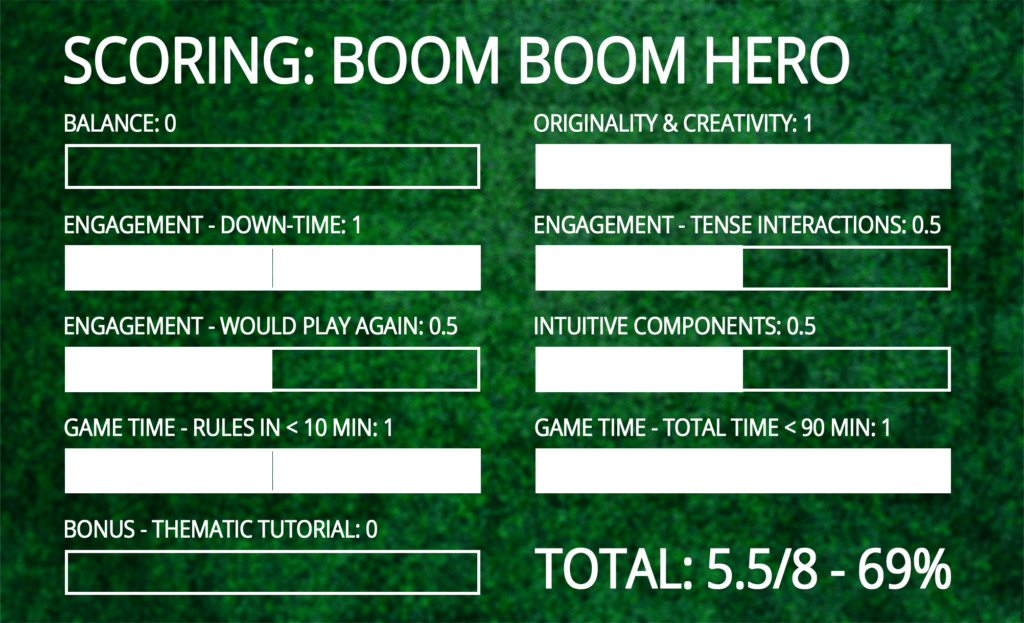
Balance: 0
With the current scoring of 10 points for meeting your goal and 1 point per correct guess of others’ goals, unless everyone misses their goal (which feels unlikely), the only way someone can win this game is to achieve their secret role’s goal.
The Champion and Assist goals both required very low damage. These were much more difficult to achieve than other goals since there are only 3 cards that allow you to reduce damage while many more inflict damage — sometimes in large amounts. In effect, this means that if you are randomly assigned the Champion or Assist role at the beginning of the game, it becomes clear to you after 2-3 rounds that you are very unlikely to win, making the rest of the game feel discouraging and futile.
Originality & Creativity: 1
Though the theme is clearly playing off of the Infinity Gauntlet, it puts its own spin on it through the art style and backstory. The game mechanics themselves mix a few familiar things to create a game play experience that feels original and memorable.
Engagement – Down-Time: 1
The simultaneous action selection helped the game zip along at a nice rate. The time we spent choosing actions and guessing other’s identities was the slowest part, but not noticeably tedious. There’s a good chance both of these slower portions could get faster with some of the suggestions I’ve made for component changes.
Engagement – Tense Interactions: 0.5
Guessing each others’ roles and making accusations was only a minor part of this game, but I wouldn’t say it was completely absent either. There were some comments like “Of course YOU would choose that,” or “Well, I guess we all know who so-and-so is.” However, the only real bluffing came from the number of energy crystals a player chose to allocate before throwing their action, and, since this was done in silence, it didn’t result in much distrustful banter.
Engagement – Would Play Again: 0.5
The overall experience of playing this game felt fun and fresh but ultimately haphazard and a bit unpolished. The balance issues keep me from wanting to play the game as written again, but I’m definitely interested in trying a future iteration.
Intuitive Components: 0.5
The the layout and fonts on the components made them both fun to use and easy to understand. However, the issues with the guessing chips were too problematic for me to give the full point for this section.
Game Time – Rules in under 10 min: 1
I found the rules easy to explain and our group was able to get started playing quickly and efficiently.
Game Time – Total Time under 90 min: 1
The whole play through came in easily under 90 minutes. I could see this making a good party game a group could enjoy playing a few times in a row.
Bonus – Thematic Tutorial: 0
The theme of this game was great, but there was no tutorial mode that used theme or story to help walk players through the process of learning how to play.
Total Score: 5.5/8 – 69%
You can see the scoring breakdown for all the semi-finalists and finalists in this game design challenge in my public scoring spreadsheet.
Credits
Thank You to my Protospiel Madison Play Test Crew
Andrew Hanson, Robert Johnson, Ben Pierro, Alisha Volkman, and Nick Volkman
Leave a Reply